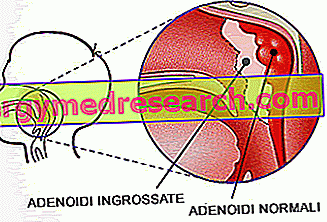What are Adenoids?
Adenoids are cluster formations consisting of lymphoid tissue. Also known as pharyngeal tonsils, they are located on the posterior wall of the nasopharynx (behind the nose).

Many of the pathogens that enter the airways pass through the adenoids, which therefore have a predominantly defensive function.
Sometimes, especially in children, adenoids can be affected by occasional or recurrent infections, which in some cases make it difficult to breathe through the nose. The most common diseases affecting adenoids can make them hypertrophic (enlarged adenoids) or inflamed (adenoiditis).
Features
Anatomy
The adenoids are found on the posterior wall of the nasopharynx (which connects the nasal cavities with the oropharynx). Together with the tonsils, they form Waldeyer's lymphatic ring, helping to create a first defensive barrier against microorganisms from the outside. White blood cells circulate through the adenoids and other lymphoid tissues, reacting to potential pathogens that penetrate the body. Histologically, the adenoids, unlike other types of tonsils, have a ciliated columnar pseudostratified epithelium.

Function
Adenoids perform immune functions: they help the body defend the body from infections, trapping and eliminating bacteria and viruses that invade the tissues around the orifices of the nasal and oral cavities.
DEVELOPMENT and INVOLUTION
The adenoids are lymphatic formations present from birth, which develop progressively reaching their maximum size at the age of about 3-5 years. Normally, a soft mound forms in the upper and rear part of the nasopharynx, just above and behind the uvula. At the age of about 7, the adenoids undergo an involution process, reducing their size due to the physiological atrophy of the adenoid tissue, which makes them barely visible during adolescence. In adulthood, they become practically inactive.
Despite being useful in preventing infections during early childhood, the body has more effective means of fighting bacteria and viruses. For this reason, if they grow excessively and cause significant breathing difficulties, they are often surgically removed together with the palatine tonsils.
Adenoid diseases
- Adenoiditis: inflammation of the adenoids, often caused by bacterial or viral infections. Infectious processes affecting adenoids can cause other health problems, including sinusitis and serious respiratory problems, especially during the night.
- Adenoid hypertrophy : adenoids can increase their size in response to infections, allergic phenomena or unclear events. Their pathological enlargement can interfere with breathing and with the correct outflow of mucus from the ear.
adenoiditis
Adenoiditis is the inflammation of the adenoids. This process is usually caused by a viral or bacterial infection. Adenoiditis occurs mainly in childhood, sometimes in association with acute tonsillitis or otitis media.
Signs and symptoms. Acute adenoiditis is characterized by fever, nasal respiratory obstruction, snoring, obstructive sleep apnea and rhinorrhoea with serous secretion (in viral forms) omuco-purulent (in bacterial forms). This typical presentation of adenoiditis makes it difficult to distinguish it from a common cold.
Symptoms due to a viral infection of the adenoids usually regress spontaneously after 48 hours; the bacterial adenoidites can instead persist up to a week.
Adenoid infections can cause a series of complications due to the extension of the inflammatory process to nearby tissues and organs, including:
- Infections of the middle ear (otitis) : the adenoids are located near the Eustachian tube, channels that connect the nasopharynx with the middle ear. Infections can spread from the nasopharynx to the ears and cause serous or purulent otitis, producing effects also on hearing.
- Sinusitis and respiratory infections : bacteria or viruses can infect other sites, such as the bronchi (bronchitis) or the lungs (pneumonia).
Responsible pathological microorganisms
Viruses that can cause adenoiditis include Adenovirus, Rinovirus and Paramyxovirus. The bacteria mainly involved are: Streptococcus pyogenes, Streptococcus pneumoniae, Moraxella catarrhalis and Staphylococcus aureus .
Diagnosis
The condition is diagnosed based on the history and physical examination. Adenoids cannot be easily visualized, so the doctor can locate the inflammatory process using an endoscope with optical fibers. Endoscopy can confirm the diagnosis by directly highlighting inflamed adenoids. A microbiological culture and a blood test can help to find the cause responsible for the symptoms, identifying the organism involved. Occasionally, x-rays or other imaging techniques can be performed to check the size of the adenoids.
Pharmacological therapy
In the case of viral adenoiditis, the administration of analgesics and antipyretics is often sufficient. Bacterial forms, on the other hand, can be treated with antibiotics, such as amoxicillin-clavulanic acid or a cephalosporin.
Surgical treatment
If the symptoms are severe or persistent, the adenoids can be surgically removed, using an adenoidectomy. Often, this option becomes necessary when adenoiditis does not respond to drug therapies and tends to become chronic. Proper surgical removal even when adenoids hamper normal breathing. After surgery, many individuals suffering from recurrent adenoiditis report significant improvement.
Adenoid hypertrophy
Adenoid enlargement is not always pathological. Commonly, it represents a reaction to infectious processes and, in most patients, causes only a slight discomfort that does not require any specific treatment. In other cases, serious or recurrent infections can lead to adenoid hypertrophy that can occlude the back of the nose and throat.
Adenoid hypertrophy can cause the following conditions:
- Recurrent ear infections ;
- Sore throat and difficulty swallowing ;
- Respiratory problems : the enlargement of the adenoids can make breathing with the nose difficult. As a result, this occurs preferentially through the mouth.
- Sleep disorders : adenoid hypertrophy can hinder normal airflow and disturb night rest. When breathing through the nose is difficult, the patient can snore or experience episodes of obstructive sleep apnea (suspension of breathing for a few seconds).
Airway obstruction can reduce airflow from the nose, causing the subject to breathe through the mouth.
In addition to hindering breathing, adenoids can block the Eustachian tube; these ducts connect the middle ear to the back of the nose, help the flow of fluids that accumulate in the middle ear and maintain the right air pressure inside the ear. Clogging of this drainage system can lead to recurrent infections and reduce hearing ability. If a child cannot hear sounds clearly, it can have consequences on learning, development and social interaction, so it is important that an ear infection is diagnosed and treated appropriately.
To learn more: Symptoms of hypertrophic adenoids
adenectomy
When to remove the Adenoids?
Adenoidectomy is a surgical procedure by which the adenoids are removed; it is indicated in children who suffer from recurrent sore throats and encounter this difficulty in breathing with the nose. Rarely, even adults need to remove them.
A doctor may recommend this procedure if the patient develops chronic ear or throat infections that:
- They do not respond to antibiotic treatments;
- They occur more than five times a year;
- They occur three times or more in a two-year period.
Adenoidectomy may be necessary if the adenoids become hypertrophic due to:
- Infection with bacteria or viruses : although infection can resolve itself, adenoids can maintain excessive size;
- Allergies : allergens (substances that trigger an allergic reaction) can irritate the adenoids and cause them to swell;
- Congenital : the fetus can develop adenoids in the womb; at birth they could be swollen.
Other indications for adenoidectomy include:
- Adenoid enlargement interferes with breathing, especially at night.
- Recurrent or persistent otitis media in children aged 3-4 years and older (may interfere with language development);
- Recurrent and / or chronic sinusitis.
After surgery, most patients:
- It has fewer throat infections, which are milder;
- It has fewer ear infections;
- Breathe better through the nose.
How an adenoidectomy is performed
Before the operation. The mouth and throat tend to bleed more easily than other areas of the body, so the doctor may request a pre-operative blood test. In the week before surgery, medicines that could affect blood clotting, such as ibuprofen or aspirin, should not be given.
Adenoidectomy involves the administration of a general anesthetic (less commonly local) and is performed in about 30 minutes. In most cases, the patient can go home the same day as the surgery.
How are the adenoids removed? The operation is performed through the mouth and involves the removal of the adenoids through currettage (scraping) or ablation. To seal the wound, the surgeon can cauterize or apply absorbable sutures.
Adenotonsillectomy . If the patient is subjected to severe or frequent attacks of tonsillitis (tonsil infection), the simultaneous removal of tonsils and adenoids could be indicated. This procedure is called adenotonsillectomy.
Trans-tympanic drainage. In the case of otitis media, adenoidectomy can be completed with a tympanostomy: through a small cut in the eardrum, a small ventilation tube is placed in the ear to drain serous, mucous or purulent secretions. Trans-tympanic drainage helps to drain the fluid that accumulates in the middle ear during the inflammatory process and reduces infection.
Recovery from an adenoidectomy
Following an adenoidectomy, the patient will need to rest for several days. Full recovery usually takes 1-2 weeks. Some medications are prescribed to reduce pain and swelling. The patient will normally be able to start drinking fluids 2-3 hours after the operation.
Possible post-operative complications
Adenoidectomy is a low-risk procedure that rarely causes complications. This is a relatively common intervention, fast and easy to carry out. However, as with all surgical procedures, there is a small risk that complications may occur, such as bleeding, allergic reactions to anesthesia or infections.
Following an adenoidectomy, some patients may experience some minor health problems, such as sore throat, difficulty swallowing, earache, stuffy nose, halitosis (bad breath) and change of voice. However, most of these disorders are temporary, rarely require specific treatment and tend to resolve within a week or two (they should not last more than four weeks).
Although adenoidectomy actually reduces the incidence and severity of infections, it must be considered that adenoids represent one of the first barriers against microbial invasions and, if removed, can facilitate the penetration of these germs into the body.



